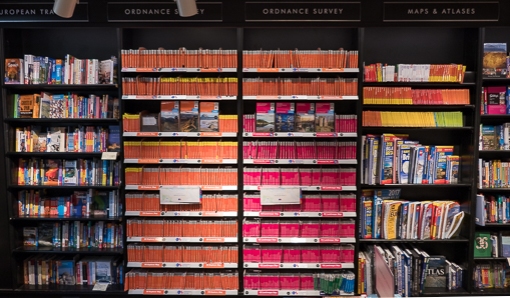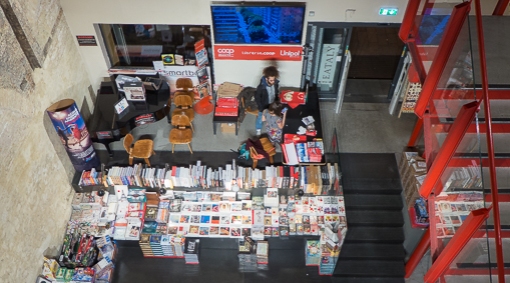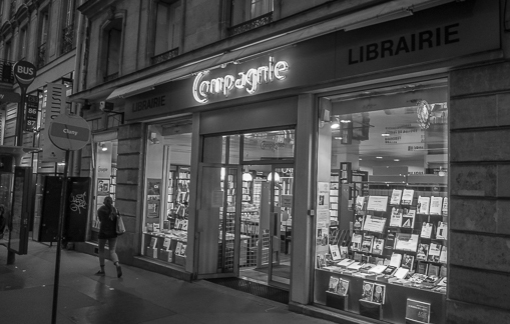This is the second post on two very different bookstores in Beijing which I(Chris) visited before the pandemic.
Page One is a bookstore chain and publisher founded in Singapore in 1983 by Mark Tan (陈家强), with locations in Singapore, Hong Kong, Taiwan, Malaysia, and Thailand, and in China (early 2010’s).

This Page One bookstore in Beijing was located in the historically commercial area of Qianmen 前門 (Zhengyangmen (正阳门) and Dashilan 大栅栏, just south of Tiananmen Square. It is now a very touristy area filled with people, souvenir stores and chain restaurants – all housed in faked old Chinese buildings.

The bookstore is situated on a side street, away from the horde. The interior cannot be more different from the chaos on the street. It is a quieter, dimly-lit, cavernous space filled with books wall to wall.

Unlike typical bookstores, it did not feel claustrophobic despite the number of volumes on display. The minimalist approach to decoration helped to maintain a calm, almost contemplative ambiance.

The overall brightness in-store was dark but the merchandises were all adequately lit and highlighted, inviting one to browse.

Like all modern bookstores, they sell toys and dolls. I guess that is one way to lure kids into a bookstore.

On each floor, several architecturally-attractive substructures were erected to create a small area separate from the main floor.
 .Some of the spaces are isolating and intimate, allowing the shopper some private time with their books.
.Some of the spaces are isolating and intimate, allowing the shopper some private time with their books.

Some are display platforms while another is for enjoying a coffee.

The cafe was operated by Kyoto Ogawa Coffee, names of the origins of the beans were in English.

The upper floors resemble a more traditional bookstore with a wood-color tone on one floor, except there were books displayed in the ceiling. Interesting but not practical for consumers.

The surprise for any first-time visitor is the dramatically-framed view of the south-facing facade of Archery Tower 箭楼, one of several buildings that constitute Qiamen 前門 or Zhengyangmen 正阳门 which once guarded the southern entry into the Imperial inner City

The Archery Tower is positioned on the central north-south axis of Beijing aligned with the Mausoleum of Mao Zedong and the Monument to the People’s Heroes in Tiananmen Square, the Tiananmen Gate itself, and the imperial throne in the Hall of Supreme Harmony in the Forbidden City, the city’s Drum and Bell Towers and the entrance to the Olympic Green in the far north.

Another floor of the bookstore concentrating on the arts and literature has a plain white theme.
Photography section

Page One began as a small shop stocking handpicked art and design books in Singapore, accumulated a loyal following over the years and evolved into a brand. We believe there are other Page One bookstores in Beijing, in Guomao – the China World Trade Center 中国国际贸易中心 and in Sanlitun 三里屯.

However, the shops outside China have been closed in Singapore in 2011, Taiwan in 2015 and Hong Kong in November 2016. We can imagine the competition Page One was facing with Taiwan’s Eslite Bookstore in the same markets. See our post on Eslite Spectrum in Hong Kong.

We cannot see the Taiwanese Eslite opening a bookstore in China, let alone in Beijing. Page One is safe for now but it had to subject itself to self-censorship – books that criticize the Chinese communist party were not stocked.

This post is written in 2021, we are not sure if this bookstore in Beijing is still operating after the pandemic. I am quite sure the Wangfujing Bookstore (featured in an earlier post) is still around.
If you have not read our earlier post on the other Beijing bookstore, click here. What a contrast !


































































 We were in awe of this late baroque Rococo decorations.
We were in awe of this late baroque Rococo decorations.





 Scrolling curves, gilding, white and pastel colors, sculpted molding, and trompe l’oeil frescoes – this church has every element of Rococo.
Scrolling curves, gilding, white and pastel colors, sculpted molding, and trompe l’oeil frescoes – this church has every element of Rococo.

































 .
.




























 Once upon a time …
Once upon a time …

















 All the offerings here appear to be quality reading materials – most if not all are in French and we are not yet proficient to understand/gauge – so we judged them by their covers.
All the offerings here appear to be quality reading materials – most if not all are in French and we are not yet proficient to understand/gauge – so we judged them by their covers.



































 Monroe and Kubrick books …
Monroe and Kubrick books …











 Livres
Livres













 Farm direct.
Farm direct.






